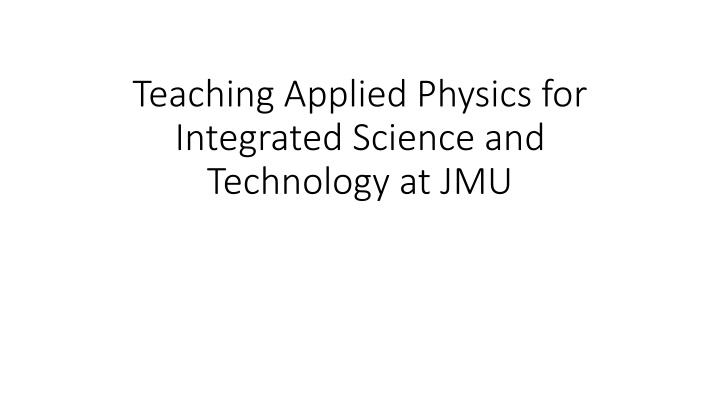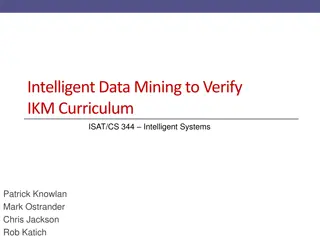
Integrated Science and Technology Physics Courses at JMU
Explore the history and development of Applied Physics courses in the Integrated Science and Technology program at JMU. From foundational classes in precalculus to upper-level studies in energy sector concepts, discover the unique approach to integrated learning. Learn about the dedicated faculty and the use of prominent textbooks in the curriculum.
Uploaded on | 3 Views
Download Presentation

Please find below an Image/Link to download the presentation.
The content on the website is provided AS IS for your information and personal use only. It may not be sold, licensed, or shared on other websites without obtaining consent from the author. If you encounter any issues during the download, it is possible that the publisher has removed the file from their server.
You are allowed to download the files provided on this website for personal or commercial use, subject to the condition that they are used lawfully. All files are the property of their respective owners.
The content on the website is provided AS IS for your information and personal use only. It may not be sold, licensed, or shared on other websites without obtaining consent from the author.
E N D
Presentation Transcript
Teaching Applied Physics for Integrated Science and Technology at JMU
Paul Henriksen BS in Physics from Loras College in Dubuque, Iowa. Research at Argonne Nat. Lab on amorphous hydrogenated silicon MS in Physics from University of Illinois at Urbana-Champaign MA History of Science from U of I History of Solid-State Physics Project History of Nuclear Weapons at Los Alamos Technical Writer and Editor for Los Alamos National Laboratory Came to JMU in 1998 as Asst. Coordinator for Students and taught ISAT math and physics classes
History of ISAT Program began in 1993 First graduating class in 1997 ABET Accredited as Applied Science major since 2006 Courses and Program constantly assessed and periodically revamped Very few other integrated programs in the U.S. where the courses are integrated as well as the major.
ISAT courses developed in real time while first class was enrolled. Initial round of ISAT math and physics classes developed by first cohort of ISAT profs including David Lawrence, Richard Roberds, Maury Wolla, and Matt Reilly
First ISAT Physics and Math classes All designated as Analytical Methods in JMU Catalog (Req for all ISAT) ISAT 141 Precalc and basic Statistics (half of each topic) ISAT 142 Applied Calculus and Physics (half of each topic) ISAT 241 Waves, Electricity and Magnetism, and Modern Physics ISAT 212 Issues in Energy (Thermo and conversion of heat to electricity) ISAT 300 Instrumentation and Measurement
Upper Level ISAT Physics classes ISAT 310 Energy Sector (Basic Fluid Mechanics) ISAT 311 (Role of Energy in Modern Society) ISAT 301 (Energy Sector Laboratory class) ISAT 410 (Sustainable Energy Development) ISAT 411 (Energy Economics and Policy) ISAT 413 (Options for Energy Efficiency) ISAT 414 (Energy Fundamentals II: more fluid mechanics)
ISAT Physics classes Used Serway and Jewett: Physics for Scientists and Engineers Ray Serway was on JMU faculty in Physics Dept. Kept basic order, but tried to include only the fundamentals
2006 Revamp Not enough Calculus and Statistics in Program Physics content was fine, but needed to be reorganized. ISAT 300 changed to be more applicable to all the ISAT Sectors Biotechnology Environment Engineering and Manufacturing Information and Knowledge Management Energy
Revamped Program 2006 to present ISAT 151 Topics in Applied Calculus for ISAT ISAT 251 Topics in Applied Statistics for ISAT ISAT 152 Topics in Applied Physics for ISAT ISAT 212 Issues in Energy (very few changes) ISAT 300 (old number new format and topics)
ISAT 152 Topics in Applied Physics for ISAT Four credit class Three 50-minute lectures per week and a 75-minute lab Unifying theme: How does light work? Combined the physics from 142 (kinematics and energy) with the entire contents of ISAT 241 (electricity and magnetism) Content still used today, but added AC Circuits and time-dependent RC and RL circuits when the old 253 class was removed from the curriculum.
ISAT 152 Course Topics First 4 weeks: Basic Kinematics and Energy Weeks 5-6: SHM, Traveling Waves and Standing Waves Weeks 7-12: Electromagnetism, Generators, and AC Electricity Weeks 13-16: Optics, Interference Phenomena, Photoelectric Effect, Bohr Model of the Hydrogen Atom, and Lasers
ISAT Physics Guiding Principles More Topics, Less Depth than traditional physics classes One Semester rather than two or three Straight-line motion only, no rotational motion, angular momentum Mostly constant forces and uniform fields, no line or surface integrals Basic use of derivatives and integration (already experienced in ISAT 151, but needed repetition) Goal is to provide a strong basis for learning more physics in the future if needed.

